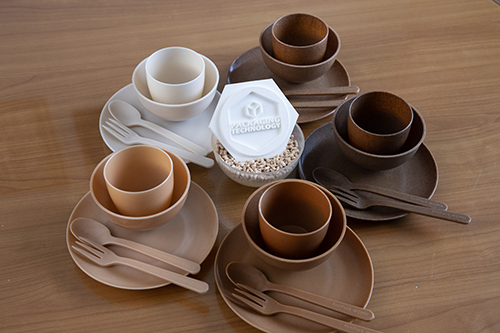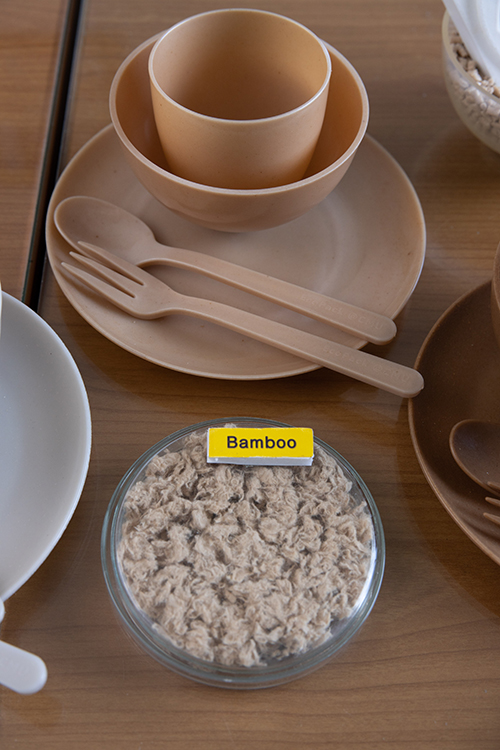Plastic pellets for bio-plastic containers

Bio-plastic containers
“Whatever has no value, using an innovative approach, can be turned into something of value,” is the philosophy behind these beautiful products.
These crockeries have been created from waste which have no value, thrown away as useless, such as rice stubbles, corn husks, coffee grounds, sugarcane bagasse, bamboo, etc. they have been given a new lease of life and turned into useful products which are good for the environment, biodegradable, clean, safe and importantly for this region, helps in reducing the annual PM2.5 air pollution which is a scourge caused by the burning of discarded agricultural waste.
The Department of Packaging Technology of Chiang Mai University’s Faculty of Agro Industry’s many experts in the field have turned to innovation to develop eco-plastic products. The aim is to serve local communities by adding value to waste in a sustainable way which benefits the environment. The department also opens up possibilities for exciting additional revenue streams.
Bio-Plastic: From Zero to Value
There are approximately 17 million rai of rice grown in the North of Thailand. Each rai of rice grown produces around 650kg of organic waste, which, when extrapolated across the region is so great that most farmers resort to burning to remove it. This contributes greatly to the annual air pollution crisis. Assistant Professor Dr. Suthaphat Kamthai of the Department of Packaging Technology saw this challenge, and responded by thinking outside the box and creating new revenue streams for farmers to earn extra income from what was once not just waste, but toxic waste.
“Instead of responding to the needs of SMEs as we usually do,” explained Assistant Professor Dr. Suthapat, “our researchers are responding to a much larger issue, and that is the vast amounts of PM2.5 which is released each year into our atmosphere by the burning of corn and rice waste in the upper North and sugarcane in the lower North of Thailand. With this new innovation, we can potentially reduce the PM2.5 pollution in the region by up to 27%.”
Researchers have worked alongside farmers on the ground to learn their real problems and challenges, resulting in the implementation of a project in Lampang Province’s Mae Tha District producing high grade rice husk paper. The next step was then to develop containers and crockeries of food grade which are of such quality that they can be microwaved.
Not only do farmers benefit from extra income, but this research also falls in line with the new government policy which aims to reduce plastic waste by banning four types of products by 2022. The four types of plastic products which are to be banned are, thin single use plastic bags, foam containers for foods, thin plastic beverage cups, and plastic straws. This policy aims to raise greater awareness of the importance of the environment and to reduce the amount of non-biodegradable plastic in the market, eventually phasing them out completely while also opening up great opportunities for the eco-plastic industry, which currently only has a 4% share of the market.
Chiang Mai University’s Faculty of Agro Industry is one of the first institutions in Thailand to turn rice stubble, sugarcane bagasse as well as waste from new economic crops such as coffee, bamboo and hemp – all of which contain high quality natural cellulose fiber – into quality and interesting products. One such example is the proliferation of beautifully designed high grade products made from just a fraction of coffee ground waste produced by Chiang Mai’s 2,000 cafes. These products include trays, coffee cups, plant pots, etc.

Containers made from coffee ground
 | |
| Containers made from bamboo fiber | Containers made from corn husk |
Cellulose Innovation for Multiple Benefits
Innovation has no limit as long as researchers do not stop thinking. This means that agricultural waste, or green waste, can be further developed in the future. Cellulose innovation has been the result of work done by the Bio-Composite and Packaging Technology Cluster team, led by Assistant Professor Dr. Suthapat.
 | |
| Hemp container products | Hemp container products |
The possibilities are virtually endless with such quality cellulose, as it can be turned into bio-degradable plastic, paper coating solution, ripeness indicator film, etc. One of the strengths of this innovation is in the small amount of chemicals needed as well reducing the production time by half. This synthetic process and production can be used with all agricultural waste. One immediate benefit is that such containers can help slow the ripening of fruits, which has large export potential.
Researchers are also applying cellulose innovation technology to hemp, a plant not only high in cellulose, but also one with long fibers and multiple active chemicals. Hemp bast and hemp shive can be turned into hemp bacteria cellulose; hemp film can be beneficial in absorbing liquid as well as halt hemp foam microorganisms used in planting material or 100% bio-degradable foam as well as hemp biodegradable packaging.
Bio-plastic Influencing a Better Future
Moving Forward by Building People and Innovation
It is clear that bio-plastic will have a role in influencing a better future. The vision of the Faculty of Agro Industry is to look into the future and develop, not just food, but also bio-plastic packaging products to meet the need of people in their daily livecs. This faculty provides space for learning, research, and academic services.
Assistant Professor Dr. Sujinda Sriwattana, Ph.D.
Agro-industry Chiang Mai University Eco Packaging (AICEP) opening ceremony

SK Film
“With funding from both the Chiang Mai University and the Faculty of Agro Industry,” explained Assistant Professor Sujinda Sriwattana, Dean of the Faculty of Agro Industry, “we have the Agro-Industry CMU Eco Packaging (AICEP) building which houses two large molds for producing plastic pellets. Our factory’s plastic pellets can be turned into multiple packaging products. As a university, we won’t be selling our products, but what we can offer is the development of formulas which businesses can purchase or license.”
Chiang Mai University has six branches of studies dedicated to turning raw agricultural material into food and non-food products, these are; Food Science and Technology, Agro-Industrial Biotechnology, Food Process Engineering, Product Development Technology, Packaging Technology, Marine Product Technology
The university’s students and faculty have taken on the mantle of innovation and will continue to find ways to add value to what is essentially waste, all for the betterment of society. The university also supports and inspires students and faculty to enter a variety of innovation competitions, opening up opportunities such as the SK Film, an edible container film, which is akin to seasoning made from rice stubble and soybean. Simply add this film to instant noodles and allow two minutes to boil.
The university plans to soon implement the usage of these products on campus by serving all food in canteens in bio-plastic containers made from coffee, rice, sugarcane, bamboo and corn waste. The environment will benefit from the repurpose of waste, farmers will have extra revenue, society will benefit as a whole and the university will continue to put research into action for the betterment of all.